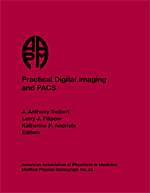
#25 Practical Digital Imaging and PACS (1999 AAPM Summer School)
Author: Anthony Seibert et alISBN: 9780944838921 ISBN10: 0944838928
Published: 1999 | 577 pp | Softcover
Price: $ 65.00
Medical Physics | December 1999
“The published proceedings of the AAPM Summer Schools are generally recognized as excellent sources of information on recent developments in medical physics and valuable references for future use. Practical Digital Imaging and PACS, the proceedings of the 1999 Summer School, continues this tradition.
“The focus of this Summer School and the proceedings is on the developments and implementation of digital imaging in medicine. It is an excellent resource for medical physicists who are working in this area. These proceedings are actually the third one dedicated to the general topic of digital imaging following the proceedings of the 1993 and 1997 Summer Schools. Even though many of the same topics are covered, it is not a duplication of the previous publications because, for the most part, it is written by different authors and the materials are updated. The book consists of 24 chapters ranging from relatively short (6 pages) overviews to much longer (33 pages) and complete treatment of the topics. A weakness of some of the chapters is that no illustrations are included.
“The topics covered fall into several categories. Some are reviews of the basic principles of the different imaging modalities such as nuclear medicine, computed tomography, ultrasound, magnetic resonance imaging, and fluoroscopy. While much of this material is basic principles, some recent developments such as multiple detector array CT scanners are described. Each of these chapters concludes with a general description of the digital images produced by the modality and some of the interfacing issues.
“The general field of digital radiography is covered by four chapters: Film Digitizers and Laser Printers, Computed Radiography Overview, Computed Radiography QA/QC, and Digital Mammography. It is unfortunate that the topic of digital radiographic receptors other than photostimulable phosphor plates was not included except as it applies to digital mammography.
“Twelve chapters are dedicated to the general topic of PACS. This includes the topics of teleradiology, date management and archiving, workstations, economic issues, networks, and the associated quality control issues.
“One very useful chapter contains a complete RFP for a PACS.
“Three chapters provide an excellent academic introduction to topics underlying the successful application of digital imaging in medicine. These are: Introduction to DICOM, Image Compression and Encryption, and Image Quality and Dose.
“This book has something for every medical physicist with an interest or active involvement in digital imaging. It is a resource for research and teaching, a guide to the general design and implementation of PACS, and gives direction for quality control activities.
Perry Sprawls
